
Macrovipera, known as the large Palearctic vipers, is a genus of vipers that inhabit the semideserts and steppes of North Africa, the Near and Middle East, and the Milos Archipelago in the Aegean Sea. Like all other vipers, they are venomous. These snakes are responsible for a number of bites in Africa and Western Asia every year. They have a reputation for being ill-tempered and can inject a lot of venom, which is why they should be considered as very dangerous. Two species are currently recognized.

Vipera berus bosniensis, the Balkan cross adder or Bosnian viper, is a venomous subspecies of viper endemic to the Balkan Peninsula.

The horned adder is a viper species. It is found in the arid region of southwest Africa, in Angola, Botswana, Namibia; South Africa, and Zimbabwe. It is easily distinguished by the presence of a single, large horn-like scale over each eye. No subspecies are currently recognized. Like all other vipers, it is venomous.
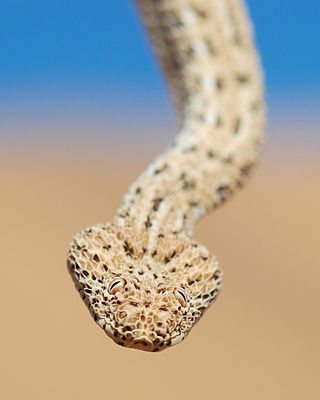
Bitis peringueyi, also known as the Peringuey's adder, Peringuey's desert adder or desert sidewinding adder, is a venomous viper species found in Namibia and southern Angola. No subspecies are currently recognized.

Macrovipera lebetinus obtusa is a venomous viper subspecies endemic to Asia, from central Turkey to northern Pakistan (Kashmir).
Vipera ammodytes gregorwallneri is a venomous viper subspecies endemic to Austria and the former Yugoslavia.
Vipera ammodytes montandoni is a venomous viper subspecies endemic to Bulgaria and southern Romania.
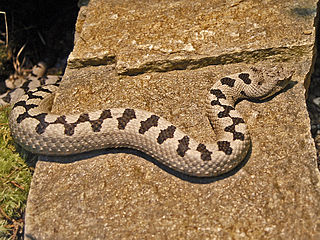
Vipera transcaucasiana is a venomous viper species endemic to parts of Georgia and northern Turkish Anatolia.

Vipera aspis atra is a venomous viper subspecies endemic to France, Switzerland and Italy.
Vipera berus sachalinensis is a viper subspecies endemic to Asia. Like all other vipers, it is venomous.

The Mount Bulgar viper, also called the Bulgardagh viper is a viper species endemic to the mountains of southern Turkey. Like all other vipers, it is venomous. No subspecies are currently recognized.
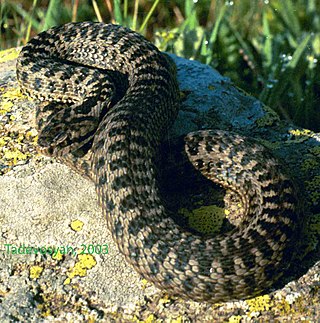
Vipera darevskii, known as Darevsky's viper, is a small species of viper, a venomous snake in the subfamily Viperinae of the family Viperidae. The species is native to northwestern Armenia, northeastern Turkey, and possibly also adjacent southern Georgia. There are no subspecies that are recognized as being valid.
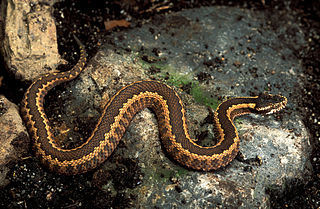
Vipera dinniki is a viper species native to the Caucasus Mountains region, part of Russia, Georgia, and Azerbaijan. Like all other vipers, it is venomous. No subspecies are currently recognized.

Vipera latastei, known as Lataste's viper, the snub-nosed viper, and the snub-nosed adder, is a species of venomous snake in the subfamily Viperinae of the family Viperidae. The species is endemic to the Iberian Peninsula and northwestern Maghreb. Three extant subspecies and one extinct subspecies are currently recognized, including the nominate subspecies described here.
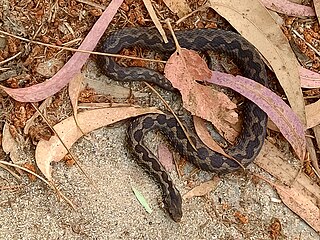
Vipera latastei gaditana is a viper subspecies endemic to southern Spain and Portugal, as well as North Africa. Like all other vipers, it is venomous.

Montivipera latifii, known as Latifi's viper, the Iranian valley viper, or the Lar Valley viper, is a species of venomous snake in the subfamily Viperinae of the family Viperidae. The species is endemic to Iran. There are no subspecies that are recognized as being valid.

Vipera lotievi, commonly known as the Caucasian meadow viper, is a species of venomous snake in the family Viperidae. The species is endemic to Azerbaijan, Georgia, and Russia. There are no subspecies that are recognized as being valid.
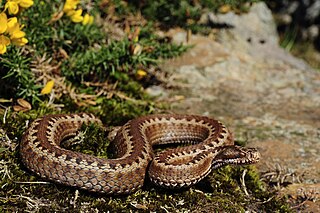
Vipera seoanei is a venomous viper species endemic to extreme southwestern France and the northern regions of Spain and Portugal. Two subspecies are currently recognized, including the nominate race described here.

Vipera ursinii is a species of venomous snake in the subfamily Viperinae of the family Viperidae. It is a very rare species, which is in danger of extinction. This species is commonly called the meadow viper. It is found in France, Italy, and Greece as well as much of eastern Europe. Several subspecies are recognized. Beyond the highly threatened European population, poorly known populations exist as far to the east as Kazakhstan and northwestern China.

Alexander Mikhailovich Nikolsky was a Russian and Ukrainian zoologist born in Astrakhan.

















